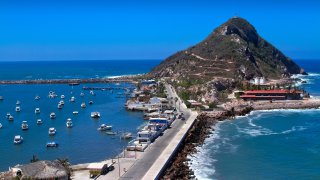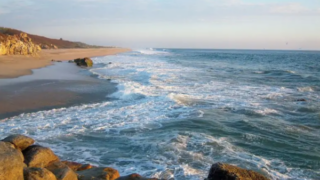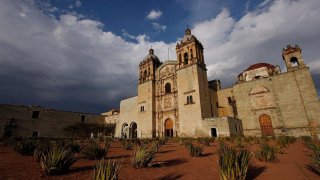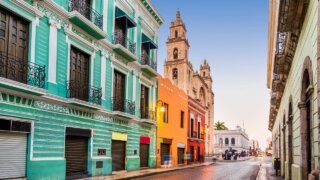Mexico’s Pacific West Coast stretches an impressive 1,700 kilometers from the northern state of Sinaloa down to the Isthmus of Tehuantepec in Oaxaca, offering one of the world’s most diverse coastal experiences. This stretch encompasses pristine beaches, mountains, fertile valleys, and cultural centers that showcase the best of Mexico’s natural beauty and rich heritage.
A Journey from Sinaloa to Oaxaca
1,700 Kilometers of Diverse Coastline
The region’s climate varies dramatically with geography: coastal areas enjoy a tropical climate with temperatures ranging from a comfortable 15°C (60°F) minimum to a warm 32°C (90°F) maximum, perfect for year-round beach activities. In contrast, the mountainous regions of the Sierra Madre del Sur offer cooler temperatures and breathtaking highland landscapes, providing relief from coastal heat and stunning panoramic views.
Northern Pacific: Sinaloa and Nayarit in the west of Mexico
Mazatlán: Mexico’s Carnival Capital
Mazatlán stands as one of Mexico’s premier beach destinations and cultural centers, most famous for hosting the country’s largest carnival celebration. This spectacular festival transforms the entire city into a vibrant street party for several days before Lent, featuring elaborate parades with towering floats, dancers in dazzling costumes, live mariachi and banda music, and non-stop festivities that rival Rio de Janeiro’s famous celebration.
Beyond carnival season, Mazatlán offers excellent beaches, a charming historic center with 19th-century architecture, world-class sportfishing, and a thriving arts scene. The city’s malecón (boardwalk) stretches for miles along golden sand beaches, perfect for sunset strolls and beachfront dining.
Nayarit: Indigenous Traditions and Sacred Art
The mystical state of Nayarit preserves some of Mexico’s most authentic indigenous cultures through the Cora and Huichol (Wixáritari) peoples, who have maintained their ancestral customs, spiritual practices, and traditional lifestyles for centuries. These communities are renowned throughout Mexico for their extraordinary artistic skills and deep connection to nature.
Sacred Craftsmanship Visitors can witness and purchase authentic handmade treasures including intricately carved wooden sculptures, brilliantly colored woven textiles, and stunning jewelry incorporating turquoise, amber, and other sacred gemstones. Each piece tells a story through traditional symbols and patterns that hold profound spiritual significance—from peyote flowers representing visions to deer symbolizing messengers between worlds.
The Huichol people are particularly famous for their yarn paintings and beadwork, creating complex geometric designs that map their spiritual journeys and cosmological beliefs. These aren’t merely decorations but sacred art forms that preserve ancient knowledge and connect the physical and spiritual worlds.
Nayarit’s Indigenous Heritage
The neighboring state of Nayarit preserves strong indigenous traditions through the Cora and Huichol peoples, who maintain their ancestral customs and spiritual practices. These communities are master artisans who create vibrant handicrafts using traditional techniques passed down through generations.
Traditional Crafts and Materials
Visitors to Nayarit can purchase authentic handmade items including wooden sculptures, woven textiles, and jewelry incorporating colorful gemstones and beads. These crafts often feature sacred symbols and patterns that hold deep spiritual meaning for the indigenous communities who create them.
Central Pacific Coast: Jalisco, Colima, and Michoacán
Puerto Vallarta and Jalisco’s Coastal Gems
Puerto Vallarta has evolved from a small fishing village into one of Mexico’s most sophisticated beach destinations while maintaining its authentic Mexican charm. The city offers world-class resorts, vibrant nightlife, excellent restaurants, and a picturesque cobblestone downtown filled with galleries and boutiques.
Regional Highlights:
- Costalegre: This “Happy Coast” features secluded luxury resorts and pristine beaches stretching south of Puerto Vallarta
- Guadalajara: Mexico’s second-largest city and cultural heart, birthplace of mariachi music and home to the country’s finest tequila distilleries
- Volcán de Colima: An active volcano offering hiking opportunities and dramatic landscapes for adventure seekers
Colima: Sportfishing Paradise
The small state of Colima punches above its weight in maritime activities. Manzanillo, known as Mexico’s “Sailfish Capital,” hosts world-renowned fishing tournaments that attract anglers from across the globe. The city also serves as one of Mexico’s most important Pacific ports, handling significant commercial shipping while maintaining excellent sportfishing facilities and beach resorts.
Michoacán: Untouched Surf Culture
Michoacán’s coastline remains one of Mexico’s best-kept secrets, particularly the remote beaches around Maruata. These rugged shores offer consistent, powerful waves that attract serious surfers seeking uncrowded breaks and authentic Mexican coastal culture. The region provides an escape from commercialized beach resorts, offering instead small fishing villages, pristine nature, and some of the Pacific Coast’s most challenging surf conditions.
Southern Pacific: Guerrero’s Contrasts
Taxco: Colonial Silver Capital
High in Guerrero’s mountains, the enchanting colonial town of Taxco represents one of Mexico’s most perfectly preserved Spanish colonial settlements. Its narrow cobblestone streets wind between whitewashed buildings with red-tile roofs, leading to the magnificent Santa Prisca Cathedral that dominates the central plaza.
Taxco has been Mexico’s silver capital since Spanish colonial times, and today visitors can explore numerous silver workshops and galleries where master craftsmen create some of the world’s finest silver jewelry using techniques passed down through generations. The town’s dramatic hillside setting and well-preserved architecture make it a UNESCO World Heritage candidate.
Beach Resorts: From Intimate to Iconic
Ixtapa-Zihuatanejo offers a perfect contrast between modern resort amenities in Ixtapa and authentic fishing village charm in nearby Zihuatanejo. The gentle waves and protected bays make this destination ideal for families and those seeking relaxation over adventure sports.
Acapulco remains Mexico’s most famous beach destination, built around one of the world’s most recognizable bays. Though past its 1950s Hollywood heyday when stars like Elvis Presley and Elizabeth Taylor vacationed here, Acapulco still offers dramatic cliff diving at La Quebrada, vibrant nightlife, and that iconic bay view that has graced countless postcards and movies.
Oaxaca: Where Culture Meets Coast
The Cultural Capital
Oaxaca represents the crown jewel of Mexican cultural destinations, where indigenous traditions blend seamlessly with colonial architecture and contemporary art. The state capital, also called Oaxaca, is considered Mexico’s culinary capital, famous for complex moles, artisanal mezcal, and innovative restaurants that have earned international recognition.
Artistic Legacy Oaxaca has produced some of Mexico’s most celebrated artists, including Rufino Tamayo, who brought international recognition to Mexican modernist painting; Francisco Toledo, known for his mystical creatures and political activism; and Rodolfo Morales, whose colorful works celebrate Oaxacan traditions and women.
Ancient Civilizations: Monte Albán and Mitla
Monte Albán, perched dramatically on a mountaintop overlooking the Oaxaca Valley, served as the Zapotec civilization’s ceremonial and political center for over 1,000 years. This UNESCO World Heritage Site features massive pyramids, intricate ball courts, and carved stone monuments that reveal one of Mesoamerica’s most sophisticated ancient cultures.
Mitla, known as the “Place of the Dead,” showcases the most intricate geometric stone mosaics found anywhere in pre-Columbian America. The site’s perfectly fitted stone patterns, created without mortar, demonstrate advanced mathematical and architectural knowledge that continues to astound archaeologists and visitors alike.
The Mexican Pacific Coast offers something for every type of traveler: from party-goers seeking Mazatlán’s carnival energy to surfers chasing perfect waves in Michoacán, culture enthusiasts exploring Oaxaca’s artistic heritage, and beach lovers relaxing in Puerto Vallarta’s luxury resorts. The region’s incredible diversity of landscapes, cultures, and experiences makes it one of Mexico’s most rewarding destinations for extended exploration.
Whether you’re drawn by ancient civilizations, indigenous art, world-class beaches, or authentic Mexican culture, the Pacific Coast provides an unforgettable journey through the heart and soul of Mexico.
























